SMS:Functional Surfaces
At a glance
- Surface with elevation based upon scalar dataset values
- Very useful for wave models and models with large change in water surface elevation
- Elevations can be exaggerated to better visualize dataset variations
- Surfaces can have a solid color or use color filled contours
- Transparency can be used to allow see through surfaces
A functional surface is exactly that. It is a surface representing one of the functional data sets associated with a mesh, grid or TIN. The most intuitive example of a functional surface is the display of the water surface over a model's bathymetry. In this case, the surface represents an actual physical surface, but the functional surface could just as easily represent the velocity magnitude, or concentration, or any other scalar quantity.
To create/display functional surfaces, the user must enable them in the display options of the appropriate module, and specify their attributes which include:
- Data set - the user selects which data set is to be used to form the functional surface.
- Z Offset - SMS displays functional surfaces at a simulated z-value. This may be the actual surface value (such as is the case with water surfaces elevations), but more often the value will not have a physical meaning, and may intersect the bathymetry or not even be in the same area. For this reason, SMS offers options for placing the functional surface at its real values, relative to the bathymetry, or at a user specified offset.
- Z Magnification - Functional data may not vary significantly when compared to the horizontal extents of the model. For this reason, the interface allows magnification (scaling) of the functional surface. By default, the surface is scaled based on the global z-magnification specified in the general display options. This may be overridden.
- Display Attributes - the user controls the color of the functional surface. It may be a constant color or colored based on the contour colors specified. The colors may be associated with the value of the functional surface, or another data set. The surface may also be partially transparent.
Related Topics
Modules: Mesh Module · Cartesian Grid Module · Scatter Module · Map Module · GIS Module · Particle Module
Models: ADCIRC · BOUSS-2D · CGWAVE · CMS-Flow · CMS-Wave · FESWMS · FVCOM · Generic Mesh Model · GENESIS · HYDRO AS-2D · PTM · SRH-2D · Steering · STWAVE · TABS · TUFLOW
